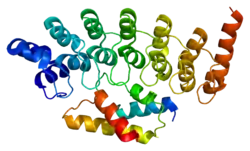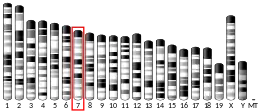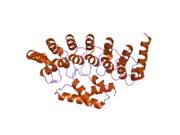26S protease regulatory subunit 6B, also known as 26S proteasome AAA-ATPase subunit Rpt3, is an enzyme that in humans is encoded by the PSMC4 gene.[5][6][7] This protein is one of the 19 essential subunits of a complete assembled 19S proteasome complex[8] Six 26S proteasome AAA-ATPase subunits (Rpt1, Rpt2, Rpt3 (this protein), Rpt4, Rpt5, and Rpt6) together with four non-ATPase subunits (Rpn1, Rpn2, Rpn10, and Rpn13) form the base sub complex of 19S regulatory particle for proteasome complex.[8]
Gene
The gene PSMC4 encodes one of the ATPase subunits, a member of the triple-A family of ATPases which have a chaperone-like activity. This subunit has been shown to interact with an orphan member of the nuclear hormone receptor superfamily highly expressed in liver, and with gankyrin, a liver oncoprotein. Two transcript variants encoding different isoforms have been identified.[7] The human PSMC3 gene has 11 exons and locates at chromosome band 19q13.11-q13.13.
Protein
The human protein 26S protease regulatory subunit 6B is 47kDa in size and composed of 418 amino acids. The calculated theoretical pI of this protein is 5.09.[9]
Complex assembly
26S proteasome complex is usually consisted of a 20S core particle (CP, or 20S proteasome) and one or two 19S regulatory particles (RP, or 19S proteasome) on either one side or both side of the barrel-shaped 20S. The CP and RPs pertain distinct structural characteristics and biological functions. In brief, 20S sub complex presents three types proteolytic activities, including caspase-like, trypsin-like, and chymotrypsin-like activities. These proteolytic active sites located in the inner side of a chamber formed by 4 stacked rings of 20S subunits, preventing random protein-enzyme encounter and uncontrolled protein degradation. The 19S regulatory particles can recognize ubiquitin-labeled protein as degradation substrate, unfold the protein to linear, open the gate of 20S core particle, and guide the substate into the proteolytic chamber. To meet such functional complexity, 19S regulatory particle contains at least 18 constitutive subunits. These subunits can be categorized into two classes based on the ATP dependence of subunits, ATP-dependent subunits and ATP-independent subunits. According to the protein interaction and topological characteristics of this multisubunit complex, the 19S regulatory particle is composed of a base and a lid subcomplex. The base consists of a ring of six AAA ATPases (Subunit Rpt1-6, systematic nomenclature) and four non-ATPase subunits (Rpn1, Rpn2, Rpn10, and Rpn13). Thus, 26S protease regulatory subunit 4 (Rpt2) is an essential component of forming the base subcomplex of 19S regulatory particle. For the assembly of 19S base sub complex, four sets of pivotal assembly chaperons (Hsm3/S5b, Nas2/P27, Nas6/P28, and Rpn14/PAAF1, nomenclature in yeast/mammals) were identified by four groups independently.[10][11][12][13][14][15] These 19S regulatory particle base-dedicated chaperons all binds to individual ATPase subunits through the C-terminal regions. For example, Hsm3/S5b binds to the subunit Rpt1 and Rpt2 (this protein), Nas2/p27 to Rpt5, Nas6/p28 to Rpt3 (this protein), and Rpn14/PAAAF1 to Rpt6, respectively. Subsequently, three intermediate assembly modules are formed as following, the Nas6/p28-Rpt3-Rpt6-Rpn14/PAAF1 module, the Nas2/p27-Rpt4-Rpt5 module, and the Hsm3/S5b-Rpt1-Rpt2-Rpn2 module. Eventually, these three modules assemble together to form the heterohexameric ring of 6 Atlases with Rpn1. The final addition of Rpn13 indicates the completion of 19S base sub complex assembly.[8] In addition, evidences indicated that the C-terminus of Rpt3 was required for cellular assembly of this subunit into 26 S proteasome.[16]
Function
As the degradation machinery that is responsible for ~70% of intracellular proteolysis,[17] proteasome complex (26S proteasome) plays a critical roles in maintaining the homeostasis of cellular proteome. Accordingly, misfolded proteins and damaged protein need to be continuously removed to recycle amino acids for new synthesis; in parallel, some key regulatory proteins fulfill their biological functions via selective degradation; furthermore, proteins are digested into peptides for MHC class I antigen presentation. To meet such complicated demands in biological process via spatial and temporal proteolysis, protein substrates have to be recognized, recruited, and eventually hydrolyzed in a well controlled fashion. Thus, 19S regulatory particle pertains a series of important capabilities to address these functional challenges. To recognize protein as designated substrate, 19S complex has subunits that are capable to recognize proteins with a special degradative tag, the ubiquitinylation. It also have subunits that can bind with nucleotides (e.g., ATPs) in order to facilitate the association between 19S and 20S particles, as well as to cause confirmation changes of alpha subunit C-terminals that form the substate entrance of 20S complex.
The ATPases subunits assemble into a six-membered ring with a sequence of Rpt1–Rpt5–Rpt4–Rpt3–Rpt6–Rpt2, which interacts with the seven-membered alpha ring of 20S core particle and establishes an asymmetric interface between the 19S RP and the 20S CP.[18][19] Three C-terminal tails with HbYX motifs of distinct Rpt ATPases insert into pockets between two defined alpha subunits of the CP and regulate the gate opening of the central channels in the CP alpha ring.[20][21] Evidence showed that ATPase subunit Rpt5, along with other ubuiqintinated 19S proteasome subunits (Rpn13, Rpn10) and the deubiquitinating enzyme Uch37, can be ubiquitinated in situ by proteasome-associating ubiquitination enzymes. Ubiquitination of proteasome subunits can regulates proteasomal activity in response to the alteration of cellular ubiquitination levels.[22]
Interactions
PSMC4 has been shown to interact with:
References
- 1 2 3 ENSG00000013275 GRCh38: Ensembl release 89: ENSG00000281221, ENSG00000013275 - Ensembl, May 2017
- 1 2 3 GRCm38: Ensembl release 89: ENSMUSG00000030603 - Ensembl, May 2017
- ↑ "Human PubMed Reference:". National Center for Biotechnology Information, U.S. National Library of Medicine.
- ↑ "Mouse PubMed Reference:". National Center for Biotechnology Information, U.S. National Library of Medicine.
- ↑ Tanahashi N, Suzuki M, Fujiwara T, Takahashi E, Shimbara N, Chung CH, Tanaka K (Mar 1998). "Chromosomal localization and immunological analysis of a family of human 26S proteasomal ATPases". Biochem Biophys Res Commun. 243 (1): 229–32. doi:10.1006/bbrc.1997.7892. PMID 9473509.
- ↑ Choi HS, Seol W, Moore DD (May 1996). "A component of the 26S proteasome binds on orphan member of the nuclear hormone receptor superfamily". J Steroid Biochem Mol Biol. 56 (1–6 Spec No): 23–30. doi:10.1016/0960-0760(95)00220-0. PMID 8603043. S2CID 46464350.
- 1 2 "Entrez Gene: PSMC4 proteasome (prosome, macropain) 26S subunit, ATPase, 4".
- 1 2 3 Gu ZC, Enenkel C (Dec 2014). "Proteasome assembly". Cellular and Molecular Life Sciences. 71 (24): 4729–45. doi:10.1007/s00018-014-1699-8. PMID 25107634. S2CID 15661805.
- ↑ "Uniprot: P43686 - PRS6B_HUMAN".
- ↑ Le Tallec B, Barrault MB, Guérois R, Carré T, Peyroche A (Feb 2009). "Hsm3/S5b participates in the assembly pathway of the 19S regulatory particle of the proteasome". Molecular Cell. 33 (3): 389–99. doi:10.1016/j.molcel.2009.01.010. PMID 19217412.
- ↑ Funakoshi M, Tomko RJ, Kobayashi H, Hochstrasser M (May 2009). "Multiple assembly chaperones govern biogenesis of the proteasome regulatory particle base". Cell. 137 (5): 887–99. doi:10.1016/j.cell.2009.04.061. PMC 2718848. PMID 19446322.
- ↑ Park S, Roelofs J, Kim W, Robert J, Schmidt M, Gygi SP, Finley D (Jun 2009). "Hexameric assembly of the proteasomal ATPases is templated through their C termini". Nature. 459 (7248): 866–70. Bibcode:2009Natur.459..866P. doi:10.1038/nature08065. PMC 2722381. PMID 19412160.
- ↑ Roelofs J, Park S, Haas W, Tian G, McAllister FE, Huo Y, Lee BH, Zhang F, Shi Y, Gygi SP, Finley D (Jun 2009). "Chaperone-mediated pathway of proteasome regulatory particle assembly". Nature. 459 (7248): 861–5. Bibcode:2009Natur.459..861R. doi:10.1038/nature08063. PMC 2727592. PMID 19412159.
- ↑ Saeki Y, Toh-E A, Kudo T, Kawamura H, Tanaka K (May 2009). "Multiple proteasome-interacting proteins assist the assembly of the yeast 19S regulatory particle". Cell. 137 (5): 900–13. doi:10.1016/j.cell.2009.05.005. PMID 19446323. S2CID 14151131.
- ↑ Kaneko T, Hamazaki J, Iemura S, Sasaki K, Furuyama K, Natsume T, Tanaka K, Murata S (May 2009). "Assembly pathway of the Mammalian proteasome base subcomplex is mediated by multiple specific chaperones". Cell. 137 (5): 914–25. doi:10.1016/j.cell.2009.05.008. PMID 19490896. S2CID 18551885.
- ↑ Kumar B, Kim YC, DeMartino GN (Dec 2010). "The C terminus of Rpt3, an ATPase subunit of PA700 (19 S) regulatory complex, is essential for 26 S proteasome assembly but not for activation". The Journal of Biological Chemistry. 285 (50): 39523–35. doi:10.1074/jbc.M110.153627. PMC 2998155. PMID 20937828.
- ↑ Rock KL, Gramm C, Rothstein L, Clark K, Stein R, Dick L, Hwang D, Goldberg AL (Sep 1994). "Inhibitors of the proteasome block the degradation of most cell proteins and the generation of peptides presented on MHC class I molecules". Cell. 78 (5): 761–71. doi:10.1016/s0092-8674(94)90462-6. PMID 8087844. S2CID 22262916.
- ↑ Tian G, Park S, Lee MJ, Huck B, McAllister F, Hill CP, Gygi SP, Finley D (Nov 2011). "An asymmetric interface between the regulatory and core particles of the proteasome". Nature Structural & Molecular Biology. 18 (11): 1259–67. doi:10.1038/nsmb.2147. PMC 3210322. PMID 22037170.
- ↑ Lander GC, Estrin E, Matyskiela ME, Bashore C, Nogales E, Martin A (Feb 2012). "Complete subunit architecture of the proteasome regulatory particle". Nature. 482 (7384): 186–91. Bibcode:2012Natur.482..186L. doi:10.1038/nature10774. PMC 3285539. PMID 22237024.
- ↑ Gillette TG, Kumar B, Thompson D, Slaughter CA, DeMartino GN (Nov 2008). "Differential roles of the COOH termini of AAA subunits of PA700 (19 S regulator) in asymmetric assembly and activation of the 26 S proteasome". The Journal of Biological Chemistry. 283 (46): 31813–31822. doi:10.1074/jbc.M805935200. PMC 2581596. PMID 18796432.
- ↑ Smith DM, Chang SC, Park S, Finley D, Cheng Y, Goldberg AL (Sep 2007). "Docking of the proteasomal ATPases' carboxyl termini in the 20S proteasome's alpha ring opens the gate for substrate entry". Molecular Cell. 27 (5): 731–744. doi:10.1016/j.molcel.2007.06.033. PMC 2083707. PMID 17803938.
- ↑ Jacobson AD, MacFadden A, Wu Z, Peng J, Liu CW (Jun 2014). "Autoregulation of the 26S proteasome by in situ ubiquitination". Molecular Biology of the Cell. 25 (12): 1824–35. doi:10.1091/mbc.E13-10-0585. PMC 4055262. PMID 24743594.
- 1 2 3 4 Ewing RM, Chu P, Elisma F, Li H, Taylor P, Climie S, McBroom-Cerajewski L, Robinson MD, O'Connor L, Li M, Taylor R, Dharsee M, Ho Y, Heilbut A, Moore L, Zhang S, Ornatsky O, Bukhman YV, Ethier M, Sheng Y, Vasilescu J, Abu-Farha M, Lambert JP, Duewel HS, Stewart II, Kuehl B, Hogue K, Colwill K, Gladwish K, Muskat B, Kinach R, Adams SL, Moran MF, Morin GB, Topaloglou T, Figeys D (2007). "Large-scale mapping of human protein-protein interactions by mass spectrometry". Mol. Syst. Biol. 3: 89. doi:10.1038/msb4100134. PMC 1847948. PMID 17353931.
- ↑ Hartmann-Petersen R, Tanaka K, Hendil KB (Feb 2001). "Quaternary structure of the ATPase complex of human 26S proteasomes determined by chemical cross-linking". Arch. Biochem. Biophys. 386 (1): 89–94. doi:10.1006/abbi.2000.2178. PMID 11361004.
- 1 2 Rual JF, Venkatesan K, Hao T, Hirozane-Kishikawa T, Dricot A, Li N, Berriz GF, Gibbons FD, Dreze M, Ayivi-Guedehoussou N, Klitgord N, Simon C, Boxem M, Milstein S, Rosenberg J, Goldberg DS, Zhang LV, Wong SL, Franklin G, Li S, Albala JS, Lim J, Fraughton C, Llamosas E, Cevik S, Bex C, Lamesch P, Sikorski RS, Vandenhaute J, Zoghbi HY, Smolyar A, Bosak S, Sequerra R, Doucette-Stamm L, Cusick ME, Hill DE, Roth FP, Vidal M (Oct 2005). "Towards a proteome-scale map of the human protein-protein interaction network". Nature. 437 (7062): 1173–8. Bibcode:2005Natur.437.1173R. doi:10.1038/nature04209. PMID 16189514. S2CID 4427026.
- ↑ Dawson S, Apcher S, Mee M, Higashitsuji H, Baker R, Uhle S, Dubiel W, Fujita J, Mayer RJ (Mar 2002). "Gankyrin is an ankyrin-repeat oncoprotein that interacts with CDK4 kinase and the S6 ATPase of the 26 S proteasome". J. Biol. Chem. 277 (13): 10893–902. doi:10.1074/jbc.M107313200. PMID 11779854.
Further reading
- Goff SP (2003). "Death by deamination: a novel host restriction system for HIV-1". Cell. 114 (3): 281–3. doi:10.1016/S0092-8674(03)00602-0. PMID 12914693. S2CID 16340355.
- Nelbock P, Dillon PJ, Perkins A, Rosen CA (1990). "A cDNA for a protein that interacts with the human immunodeficiency virus Tat transactivator". Science. 248 (4963): 1650–3. Bibcode:1990Sci...248.1650N. doi:10.1126/science.2194290. PMID 2194290.
- Dubiel W, Ferrell K, Rechsteiner M (1994). "Tat-binding protein 7 is a subunit of the 26S protease". Biol. Chem. Hoppe-Seyler. 375 (4): 237–40. doi:10.1515/bchm3.1994.375.4.237. PMID 8060531.
- Matoba R, Okubo K, Hori N, Fukushima A, Matsubara K (1994). "The addition of 5'-coding information to a 3'-directed cDNA library improves analysis of gene expression". Gene. 146 (2): 199–207. doi:10.1016/0378-1119(94)90293-3. PMID 8076819.
- Shaw DR, Ennis HL (1993). "Molecular cloning and developmental regulation of Dictyostelium discoideum homologues of the human and yeast HIV1 Tat-binding protein". Biochem. Biophys. Res. Commun. 193 (3): 1291–6. doi:10.1006/bbrc.1993.1765. PMID 8323548.
- Ohana B, Moore PA, Ruben SM, Southgate CD, Green MR, Rosen CA (1993). "The type 1 human immunodeficiency virus Tat binding protein is a transcriptional activator belonging to an additional family of evolutionarily conserved genes". Proc. Natl. Acad. Sci. U.S.A. 90 (1): 138–42. Bibcode:1993PNAS...90..138O. doi:10.1073/pnas.90.1.138. PMC 45615. PMID 8419915.
- Dubiel W, Ferrell K, Rechsteiner M (1993). "Peptide sequencing identifies MSS1, a modulator of HIV Tat-mediated transactivation, as subunit 7 of the 26 S protease". FEBS Lett. 323 (3): 276–8. doi:10.1016/0014-5793(93)81356-5. PMID 8500623. S2CID 26726988.
- Seeger M, Ferrell K, Frank R, Dubiel W (1997). "HIV-1 tat inhibits the 20 S proteasome and its 11 S regulator-mediated activation". J. Biol. Chem. 272 (13): 8145–8. doi:10.1074/jbc.272.13.8145. PMID 9079628.
- Nakamura T, Tanaka T, Takagi H, Sato M (1998). "Cloning and heterogeneous in vivo expression of Tat binding protein-1 (TBP-1) in the mouse". Biochim. Biophys. Acta. 1399 (1): 93–100. doi:10.1016/s0167-4781(98)00105-5. PMID 9714759.
- Madani N, Kabat D (1998). "An Endogenous Inhibitor of Human Immunodeficiency Virus in Human Lymphocytes Is Overcome by the Viral Vif Protein". J. Virol. 72 (12): 10251–5. doi:10.1128/JVI.72.12.10251-10255.1998. PMC 110608. PMID 9811770.
- Simon JH, Gaddis NC, Fouchier RA, Malim MH (1998). "Evidence for a newly discovered cellular anti-HIV-1 phenotype". Nat. Med. 4 (12): 1397–400. doi:10.1038/3987. PMID 9846577. S2CID 25235070.
- Mulder LC, Muesing MA (2000). "Degradation of HIV-1 integrase by the N-end rule pathway". J. Biol. Chem. 275 (38): 29749–53. doi:10.1074/jbc.M004670200. PMID 10893419.
- Zhang QH, Ye M, Wu XY, Ren SX, Zhao M, Zhao CJ, Fu G, Shen Y, Fan HY, Lu G, Zhong M, Xu XR, Han ZG, Zhang JW, Tao J, Huang QH, Zhou J, Hu GX, Gu J, Chen SJ, Chen Z (2001). "Cloning and Functional Analysis of cDNAs with Open Reading Frames for 300 Previously Undefined Genes Expressed in CD34+ Hematopoietic Stem/Progenitor Cells". Genome Res. 10 (10): 1546–60. doi:10.1101/gr.140200. PMC 310934. PMID 11042152.
- Hartmann-Petersen R, Tanaka K, Hendil KB (2001). "Quaternary structure of the ATPase complex of human 26S proteasomes determined by chemical cross-linking". Arch. Biochem. Biophys. 386 (1): 89–94. doi:10.1006/abbi.2000.2178. PMID 11361004.
- Ishizuka T, Satoh T, Monden T, Shibusawa N, Hashida T, Yamada M, Mori M (2001). "Human immunodeficiency virus type 1 Tat binding protein-1 is a transcriptional coactivator specific for TR". Mol. Endocrinol. 15 (8): 1329–43. doi:10.1210/mend.15.8.0680. PMID 11463857.
- Dawson S, Apcher S, Mee M, Higashitsuji H, Baker R, Uhle S, Dubiel W, Fujita J, Mayer RJ (2002). "Gankyrin is an ankyrin-repeat oncoprotein that interacts with CDK4 kinase and the S6 ATPase of the 26 S proteasome". J. Biol. Chem. 277 (13): 10893–902. doi:10.1074/jbc.M107313200. PMID 11779854.
- Sheehy AM, Gaddis NC, Choi JD, Malim MH (2002). "Isolation of a human gene that inhibits HIV-1 infection and is suppressed by the viral Vif protein". Nature. 418 (6898): 646–50. Bibcode:2002Natur.418..646S. doi:10.1038/nature00939. PMID 12167863. S2CID 4403228.
- Huang X, Seifert U, Salzmann U, Henklein P, Preissner R, Henke W, Sijts AJ, Kloetzel PM, Dubiel W (2002). "The RTP site shared by the HIV-1 Tat protein and the 11S regulator subunit alpha is crucial for their effects on proteasome function including antigen processing". J. Mol. Biol. 323 (4): 771–82. doi:10.1016/S0022-2836(02)00998-1. PMID 12419264.





